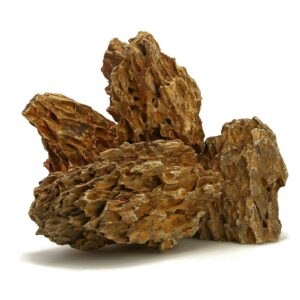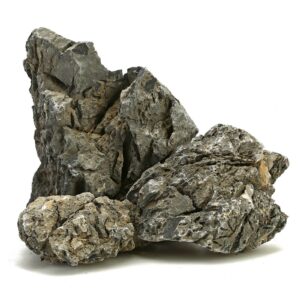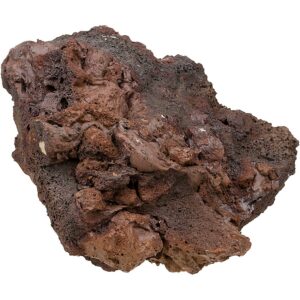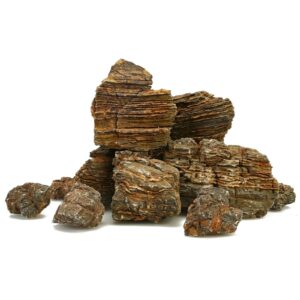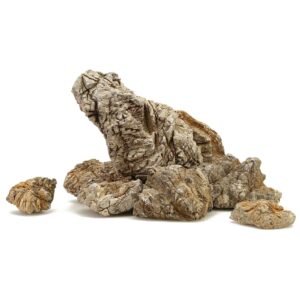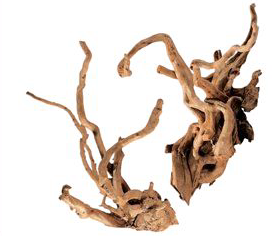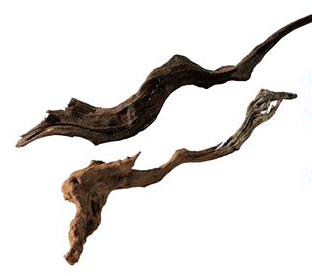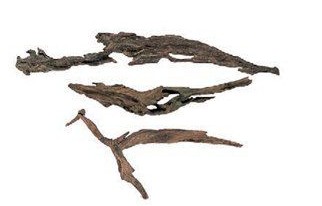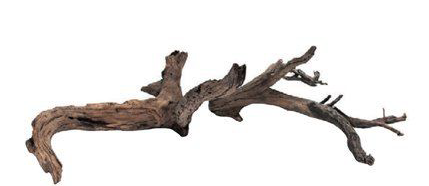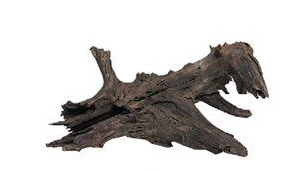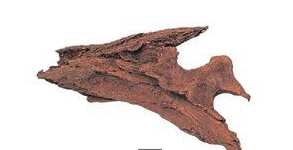An important point in selecting layout materials is to place top priority on the size that fits your aquarium tank and then on the shape. Another thing to note is to get to know the characteristics of each layout material because different types of materials have different impact on the aquarium water quality
Basically we discern between rocks that are neutral in water and rocks that slightly harden the water. While rocks like lava or dragon stones do not influence the water quality, especially those rocks with a beautifully rugged surface like for example Seiryu Rock or Grey Mountain Stone do contain a little lime and thus may harden the water a bit.
In order to keep the water hardness down anyway we recommend changing larger amounts of water frequently. Use demineralized water or water from a reverse osmosis system to refill the tank.
It is highly recommendable to clean each and every piece of rock thoroughly or at least rinse it carefully under running water before you place it in your aquarium. Doing so you’ll remove tiny dust particles that would otherwise cloud the water, especially in new tanks.
Especially Dragon Stone, also called Ohko Stone, is notorious for containing loam deposits in its many nooks and crannies. Remove those with a sharp object and rinse the stones very thoroughly before you place them in your tank.
Dragon Stone
Dragon Stone, also called Ohko, is an argillaceous rock that does not influence the water hardness, and whose holey structure and warm earthen tones make it an eye-catcher for your aquascape that gives it a very natural impression.
Seiryu Rock
Highly jointed surface, Grey colors, Perfect for Aquascaping, Raises water hardness
These are rocks of limestone origin, along with Dragon Stone and Mountain Stone are the most used in Takashi Amano’s layouts, the color is from dark gray to light gray with white veins. They are very famous for their rich coves and crevices, they recall rocky landscapes and are great for epiphytic plants and Iwagumi aquariums; being of limestone origins, unfortunately release carbonates and therefore alter the values of water, so it will have to be used in little quantity in the composition of the layout
Lava Rock
These stones are natural aggregates of lava of volcanic origin and therefore very light because they are exceptionally very porous. This is a good feature for the total weight on the glass of the tank, but the most important feature of these rocks is the presence of millions of micro-holes that will help the establishment of nitrifying bacteria, such as Nitrobacter and Nitrosomonas, propedeutic to aquarium development. For this reason it is also used in reduced forms as a substrate to facilitate the water flow and to make the bottom more oxygenated. Another excellent quality is also to not alter the water values
Black Lava Rock
Very dark color
Does not harden the water
Black Lava is of volcanic origin, featuring a porous texture, making it very lightweight and versatile
Porous structure – ideal for Ferns and Mosses
Also a classical Iwagumi can be made from Black Lava since the very dark colors make for a good contrast to the grey color of the more commonly used kinds of stone. As an advantage Black Lava does not increase the hardness of the tank water.
Lava rock is often used in conjunction with roots. The individual stones can be covered with moss to form forest-inspired scapes.
Black Pagoda
Very dark with sligh brown colors / Layered structure / Perfect for Aquascaping / Raises water hardness slightly
Black Pagoda is a very attractive brown to anthracite-colored stone. Smaller pieces are very rugged, larger ones have different layers, hence the name “pagoda”. This rock also hardens the water slightly.
Elephant Skin Rocks
Highly jointed surface / Grey,Brown colors / Perfect for Aquascaping / Slightly raises water hardness
Grey Rocks or Elephant Skin (or Seegebirge) stones are strongly textured and fit very well into an aquascaped layout. Their natural-looking surfaces make them ideal for larger rock compositions in your aquascape. These stones harden the water slightly, however, you can easily compensate for this effect by large water changes.
- Most suitable for beginners, This wood features an attractive figure created by branching, and helps you to produce an impressive layout
- For an expression, which evokes an image of the driftwood roots spreading under water
- Recommended for Aquarists who can make a composition with a combination of several branches
- For a wild layout modeled on the wood’s native environment which is also a habitat for tropical fish
Amazon Wood
An authentic piece of Amazonian Driftwood collected
Branch Wood
Popular driftwood with its attractive multi-branching form. Your aquarium looks cool just by placing this driftwood in it
Horn Wood
Drift wood of various shapes with surface colors ranging from brown to reddish brown
Keep a stock of well-shaped horn woods, will be useful in near future 🙂
Jati Wood
Usually available in thin branches.
Suitably used in combination with several branches.
Old Black Wood
Black driftwood in a branch form
This is commonly used to be one of ADA’s major driftwood in their layouts
White Wood
Relatively thick driftwood whitish in color.
Has the tendency to leach a lot of tannin
Drift Wood II
Hard , Solid driftwood resembling ebony and rosewood.
Not available commonly in aquarium trade due to limited availability
Philippine Drift Wood
Although not dealt & used by ADA, this is a good driftwood which is popularly seen.
The good thing about this driftwood is easy accessibility
- Most suitable for beginners, This wood features an attractive figure created by branching, and helps you to produce an impressive layout
- For an expression, which evokes an image of the driftwood roots spreading under water
- Recommended for Aquarists who can make a composition with a combination of several branches
- For a wild layout modeled on the wood’s native environment which is also a habitat for tropical fish
